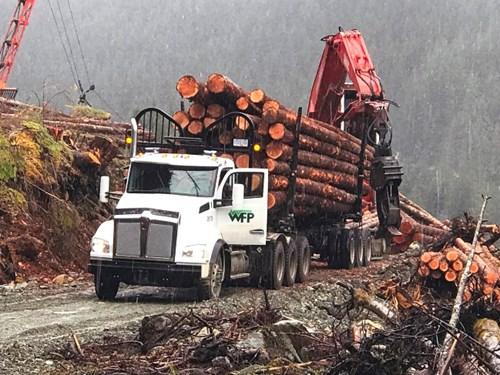VANCOUVER - Canada is the home and native land of Western Forest Products, the largest coastal timberlands operator and lumber producer in British Columbia. For years, the company, which has an annual available harvest greater than 6 million cubic meters (2.5 billion board feet), has relied on a private railway and off-road trucks to move logs to its sort yards, where they then were towed by water to their seven sawmills on Vancouver Island.
Transporting logs by rail – something the company had been doing for decades, will be replaced by highway truck hauling, says Western Forest Products senior maintenance manager Rick Bitten. The railway was used in conjunction with off-highway trucks capable of hauling 60 to 80 ton loads, which were transferred by a reload to the rail cars. The downside of the “Fat Trucks” is the parts are becoming more difficult to source and they are restricted to off-highway hauls.
That’s all now changing. In a move that Bitten called an “evolution” to increase cost competitiveness and improve efficiencies, Western Forest Products turned to the Kenworth T880 to do double-duty – transporting timber off- and on-highway. Kenworth is a manufacturer of heavy and medium duty trucks.

The Western Forest Products fleet numbers 75 trucks, including some well-used Kenworth T800s and 24 new Kenworth T880s.
The T880s were specifically spec’d to handle 60-ton payloads. Specialty features include an 11-5/8-inch double frame rail with additional cross-members for added strength, Neway 78,000-pound tridem 54-inch air suspension, and a Meritor 20,000-pound drop axle. Profab Manufacturing added custom cab guards, bunks, and trailer components.
“The engineering solution from Kenworth was far more in-depth than the solutions we received from the other OEMs we evaluated,” Bitten said. “There were a whole lot of criteria coming back from Kenworth on what would be required to achieve the 60-ton rating. We liked the idea of them telling us what was required to meet the need.”

In comparing makes and models, Western Forest Products looked at 40 specific points, including safety, durability, efficiency, serviceability, support, parts availability, and driver comfort, graded on a scale of 1 to 3 with two being average and three being exceptional. “Kenworth and the T880 came out ahead,” Bitten said.
Durability was a key factor, as the trucks average 12.4 miles of off-road conditions each trip with most trucks making three to five trips a day, depending on haul distance. Some of the mainline roads are fairly well maintained, but spur roads can prove a challenge. The spur roads don't have a lot of ballast on top, so there can be some really rough surfaces.

Any incline above 22 percent is called “steep-slope” hauling; Western Forest Products trucks can face 26 to 28 percent grades. To handle that, the Kenworth T880s are equipped with 565-hp engines and a 5:25 gear ratio. Tridem drive axles with locking differentials, and automated Eaton UltraShift® Plus transmissions – designed for vocational applications and including the Hill Start Aid feature – also help navigate mountain terrain.
“Some of our hauls are very demanding, and driver focus is critical. The UltraShift transmission allows the driver to focus on controlling the truck,” Bitten said. “The Eaton UltraShift is a huge step forward for us,” Bitten added. “We went in that direction because of the age of our workforce, the ergonomics of the transmission and also for the advantages of reduced maintenance costs.”

According to Bitten, the Kenworth T880 is one of the few trucks in which a driver can actually have three-point contact while climbing in and out of the cab. Kenworth also designed the engine compartment for easy access to maintenance items, and a self-locking mechanism ensures the hood remains in a safe position when open. “These little features benefit both our drivers, and technicians,” Bitten said.
And then there are the mirrors – something Bitten liked to point out. “The fat trucks we operate are equipped with ‘West Coast’ style mirrors that stick out far enough to allow drivers to see past the wide 10-foot, 6-inch bunks,” he said. “But, because of the rough roads, they tend to shake out of adjustment creating delays while readjusting. The T880 solved that issue with standard spec modular mirrors with electronic adjustments.”






Have something to say? Share your thoughts with us in the comments below.